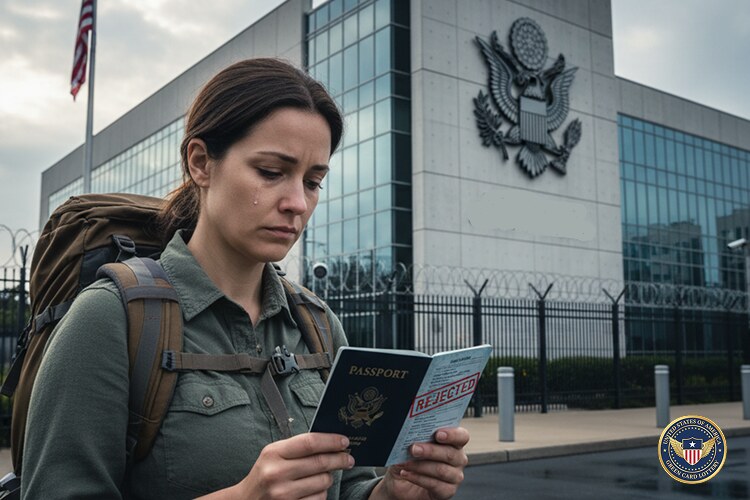
Introduction: Why B-1 B-2 Visa Rejections Are So Common
The B-1 B-2 Visa is one of the most popular U.S. visa categories, allowing millions of visitors each year to travel for business or leisure. However, despite being a non-immigrant visa, rejection rates remain high in some countries, exceeding 30–40%.
A visa rejection can be frustrating, especially when you’ve spent time, effort, and money preparing. But most denials stem from simple mistakes or misunderstandings that applicants could easily avoid.
In this comprehensive guide, we’ll explore the most common reasons B-1/B-2 visas get rejected, explain what consular officers look for, and share practical steps to improve your approval chances.

Table of Contents
What Is a B-1/B-2 Visa?
The B-1/B-2 visa is a temporary visitor visa issued to people traveling to the U.S. for business (B-1) or tourism/medical purposes (B-2).
B-1 (Business Visitor Visa)
For attending business meetings, conferences, contract negotiations, or short-term professional engagements without being employed in the U.S.
B-2 (Tourist Visa)
For leisure, visiting family or friends, or seeking short-term medical treatment.
Though the application process is straightforward, the challenge lies in convincing the consular officer that you will return home after your visit. This is where most applicants fail.

1. Weak Ties to Home Country (Section 214(b) Denial)
The most frequent reason for B-1/B-2 visa rejection is failure to prove strong ties to your home country under Section 214(b) of the Immigration and Nationality Act.
What Happens
The U.S. officer believes you might not return home and instead overstay your visa.
How to Avoid It
- Show employment proof (job letter, payslips, company ownership).
- Provide evidence of family responsibilities, property, or ongoing education.
- Avoid saying anything that suggests you plan to stay permanently.
- Keep your explanation honest and consistent; officers can easily detect scripted answers.

2. Incomplete or Incorrect DS-160 Form
The DS-160 form is the foundation of your visa application. Errors or inconsistencies here are a red flag for visa officers.
Common Mistakes
- Typographical errors in your name or passport number.
- Inconsistent travel purpose (e.g., marking tourism but mentioning business in your interview).
- Skipping employment or family information.
How to Avoid It
- Double-check every field before submission.
- Use the official CEAC website only.
- Print and keep your DS-160 confirmation page safe for your interview.
Tip: If you ever plan to immigrate permanently, services like the U.S. Green Card Office can help you submit error-free Diversity Visa applications, ensuring compliance with all U.S. immigration requirements.
3. Weak or Inconsistent Interview Answers
Your visa interview is when the final decision is made. Even if your documents are perfect, poor communication or nervousness can lead to rejection.
Common Mistakes
- Giving vague or contradictory responses.
- Failing to explain your purpose clearly.
- Appearing uncertain about your travel dates or plans.
How to Avoid It
- Prepare clear, truthful answers.
- Be concise, don’t overshare unnecessary details.
- Dress neatly and remain polite.
Example:
Wrong: “I just want to see how life is in the U.S.”
Right: “I plan to visit my cousin in Los Angeles for three weeks during my annual leave.”
4. Insufficient Financial Proof
Visa officers need confidence that you can afford your trip without working in the U.S.
What Causes Rejection
- Low or unexplained bank balance.
- Lack of proof showing how you’ll cover travel and living costs.
- Dependence on someone in the U.S. without clear financial ties.
How to Avoid It
- Provide recent 3–6 month bank statements.
- Include salary slips, business income, or tax returns.
- If someone is sponsoring you, include their affidavit of support and proof of relationship.
5. Previous Immigration Violations or Overstays
If you have previously overstayed in the U.S. or violated visa conditions, your application is at high risk.
What Happens
Officers access your full immigration record. Even minor overstays or unauthorized work can trigger an automatic denial.
How to Avoid It
- Be honest about your past travel history.
- If there was a genuine reason (medical emergency, flight cancellation), provide documentation.
- Avoid reapplying immediately after a denial wait; address any issues, then reapply.
6. Inappropriate or Low-Quality Visa Photo
It sounds minor, but a rejected photo can delay or invalidate your application.
Common Issues
- Wrong dimensions (must be 2×2 inches).
- Shadows, glare from glasses, or an improper background.
- Edited or filtered photos.
How to Avoid It
- Follow official U.S. visa photo requirements.
- Use a professional photo service or online tool.
- Avoid selfies or scanned photos.
(The same photo guidelines apply to the Diversity Visa, where the U.S. Green Card Office provides a professional photo correction and verification service.)

7. Unclear Travel Purpose or Weak Documentation
If your itinerary doesn’t match your travel reason, consular officers may suspect hidden intentions.
What Causes Concern
- No proof of hotel bookings or return ticket.
- Inviting letters are missing verification.
- Unclear schedule or purpose of meetings.
How to Avoid It
- Show a realistic itinerary (flights, hotels, events).
- Carry a letter of invitation (if visiting family or attending business).
- Have printed confirmations to show consistency.
8. Previous Visa Denials Without Change in Circumstances
Reapplying without addressing the reason for your earlier denial usually leads to another rejection.
How to Avoid It
- Review your refusal sheet carefully.
- Wait at least 3–6 months before reapplying.
- Gather stronger documentation to fix the issue.
9. Poor Understanding of Visa Category
Some applicants mix up visa types, applying for a B-2 (tourist) visa when their purpose is actually business.
How to Avoid It
- Apply for B-1 if your purpose is business-related (meetings, conferences).
- Apply for a B-2 for tourism or family visits.
- Always match your DS-160 form to your actual intent.
10. Misrepresentation or Dishonesty
Lying about employment, marital status, or purpose of travel is one of the fastest ways to get permanently banned.
How to Avoid It
- Always tell the truth; officers have access to background databases.
- Present documents that genuinely support your statements.
- Never use fake employment letters or financial documents.
Final Advice: Professional Guidance Matters
Applying for a B-1/B-2 visa requires precision, honesty, and good preparation. A single inconsistency can trigger a denial under Section 214(b).
While these are non-immigrant visas, many applicants later wish to immigrate permanently. In such cases, it’s better to seek professional support.
The U.S. Green Card Office assists applicants worldwide in applying for the Diversity Visa (Green Card Lottery), a government-approved path to permanent residency. They ensure error-free applications and even review your photos professionally, reducing the risk of disqualification.
Conclusion
Rejection of a B-1/B-2 visa can be disappointing, but it doesn’t mean your U.S. travel dream is over. By understanding why denials occur and preparing more substantial evidence, you can significantly improve your chances on your next attempt.
And if your goal is long-term residence rather than short visits, applying for the Diversity Visa through the US Green Card Office is the most innovative way to start your journey toward permanent U.S. residency safely and professionally.


